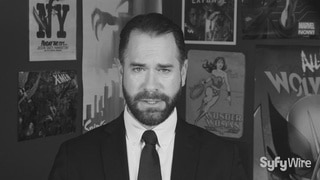Create a free profile to get unlimited access to exclusive videos, sweepstakes, and more!
How an Intense Heat Wave Almost Derailed the Second Twilight Zone Episode Ever Produced
The first Twilight Zone episode produced after the series was ordered dealt with some hot situations.
The anthology format of The Twilight Zone (airing regularly on SYFY) meant that every new episode brought with it an entirely new set of production challenges, from casting to costume design to, of course, finding the right set or location to make the often far-flung stories work. Sometimes, these challenges were straightforward matters of TV production, but other times they got a bit more extreme.
For instance, take the story of the very first Twilight Zone episode to go into production after the pilot episode, "Where Is Everybody?", got the series greenlit. To make it work, the show's newly formed crew had to deal with some of the most intense heat ever put on film, and that was just the beginning.
How "The Lonely" became the hottest Twilight Zone episode ever
Though it was the seventh episode to make it to air in The Twilight Zone's first season, "The Lonely" was actually the first in the initial series order to be produced. The story follows a man convicted of murder (Jack Warden) who's sentenced to solitary confinement on an asteroid, where he lives with no companions and few ways to pass the time. This changes one day when the supply ship that periodically visits him leaves behind an android (Jean Marsh) in the form of a beautiful woman. The two develop a connection, until unexpected consequences of their relationship lead to a shattering conclusion.
According to Marc Scott Zicree's The Twilight Zone Companion, to make the asteroid landscape look realistic, producer Buck Houghton and director Jack Smight decided to shoot in Death Valley in California, one of the hottest and driest places in the world. The desolation, they realized, would look great on camera, but shooting there in June of 1959 also brought with it another consequence of the climate: extreme heat.
"That was unbelievable heat when we shot out there," Smight recalled. "The temperature was around 130 degrees. One day the caterer very foolishly served a very heavy meal for lunch, and about eight crew members just dropped in the afternoon."
The heat continued to impact the crew to such a degree that the ones left standing were filling in for their fallen comrades, and assistant director Edward Denault later recalled to Zicree that he'd even served as a boom mic operator for some shots. At one point, when Marsh was asked to lie on the ground for a shot, a thermometer laid next to her registered 140 degrees.
The heat was so intense, and the area so dry, that it even interfered with some very basic makeup tricks. To emphasize the heat, the cast members were sprayed with a mixture of water and oil to exaggerate their sweaty appearance, but Death Valley was so hot and arid that the water would evaporate away in moments, leaving the cameras without the sweat effect.
"We ended up putting about 90 percent oil and a little water on their faces," director of photography George Clemens recalled, "and the oil would stay in little droplets."
Eventually, the heat got so intense -- Clemens himself apparently fell off a camera rig at one point because of it -- that Smight and Houghton made the decision to retreat to a soundstage to finish the episode.
"It was just too hot," Smight said.
The Twilight Zone airs regularly on SYFY. Check the Schedule for listings.































